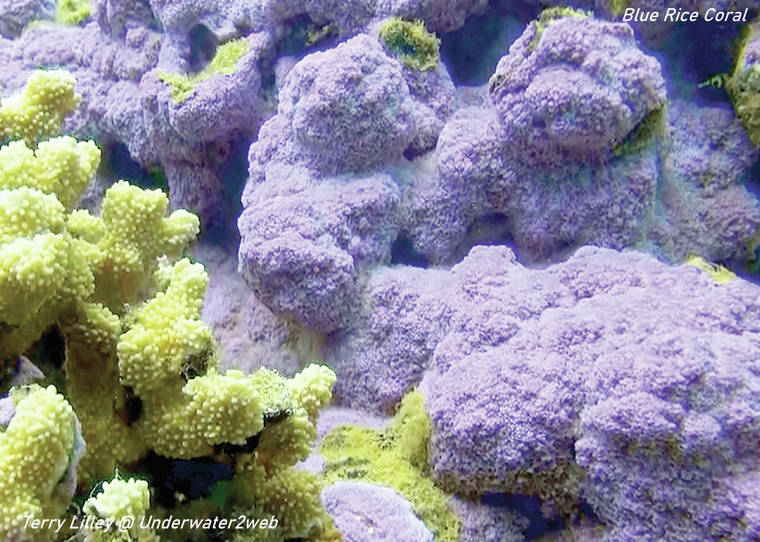We have bright blue and purple corals that live in very shallow water here in Hawai‘i and also occur on other Pacific Islands from Palau to Tahiti! These corals are just stunning to look at because they are quite flat and spread out over the reef making an entire blue reef in some spots. When the first northern outside explorers arrived in Hawai‘i hundreds of years ago they wrote in the journals that they sailed into bays where the reef was as blue as the sky!
We have bright blue and purple corals that live in very shallow water here in Hawai‘i and also occur on other Pacific Islands from Palau to Tahiti! These corals are just stunning to look at because they are quite flat and spread out over the reef making an entire blue reef in some spots. When the first northern outside explorers arrived in Hawai‘i hundreds of years ago they wrote in the journals that they sailed into bays where the reef was as blue as the sky!
What happened to these Hawaiian blue coral reefs? The blue rice coral is called rice coral as it looks like grains of rice growing on the reef. The coral gets its color from a type of algae it grows in the coral polyp tissue and also from certain minerals it absorbs from the sea water. The hard calcium carbonate part of the rice coral is pure white and sometimes when the blue rice coral loses its algae the coral bleaches and turns pure white.
The blue rice coral is a very thin coral and it spreads out over the reef in a thin layer that is usually less than a half an inch thick. Other corals like the giant mound corals, finger corals and antler corals may be five-to-10-feet thick. The blue rice coral may be four foot wide but very thin so it has more surface area vs volume exposed to the sea water then the giant corals do, so it is more susceptible to diseases and pollution. It is like a big sheet on your bed will attract more dust than a basketball sitting on the bed. A flat coral also traps more particles like sediment in the water than a large round coral would.
When our ocean surrounding Hawaii suffers from pollution problems from storm runoff, sewage leaks, oils from vehicle traffic, pesticide runoff, military and boat sonar and other types of pollution problems the blue rice corals are the first coral species to die. They are the “canary in the coal mine” as they can tell us that there is a problem out on our coral reefs we may not be aware of.
This very thing has happened several times over the past 10 years. The blue rice corals can grow right in the pounding surf because they are flat and won’t get ripped off of the reef. At times they have bleached then died off and we see that while we are surfing. Even while riding a big wave we can see the white patches on the reef as we ride over them.
The good thing about the blue rice corals is they are also the fastest growing coral we have on our reefs! When the pollution problems are fixed in the sea then these corals will grow back within a few short years so if we want to once again have the beautiful Hawaiian blue bays then we must stop polluting our near shore reefs and nurture our amazing blue rice corals back to health.
You can see the beautiful blue rice corals in my movie “The World’s Guide To Hawaiian Reef Creatures” up on my underwater educational web at www.underwater2web.com and follow my weekly marine life and surf post on my Instagram at terry.lilley.
•••
Terry Lilley is a marine biologist living in Hanalei and co-founder of Reef Guardians Hawai‘i, a nonprofit on a mission to provide education and resources to protect the coral reef. To donate to Reef Guardians Hawaii go to www.reefguardianshawaii.org.

Subscribe today for unlimited access.
Already a subscriber?
Login
Not ready to subscribe?
Register for limited access.
If you have a print subscription but require digital access,
activate your account.





